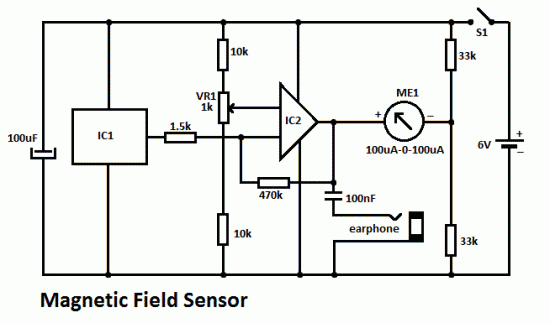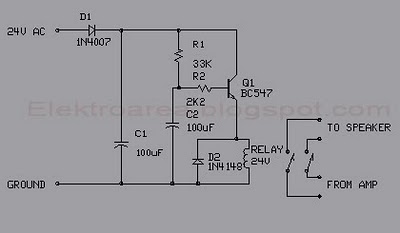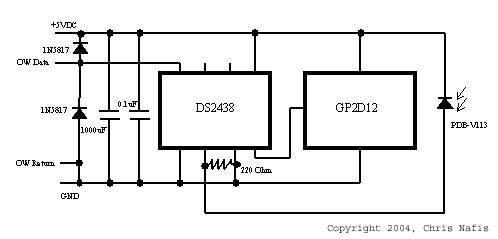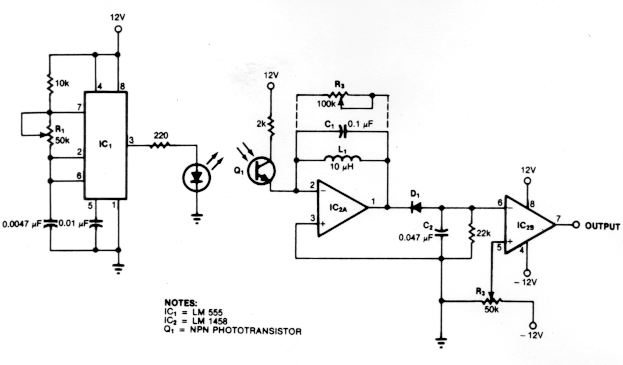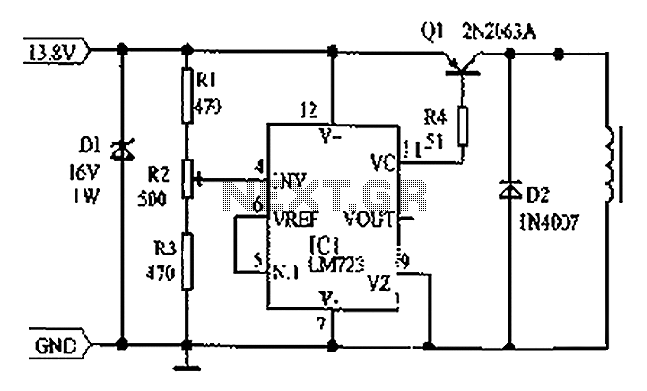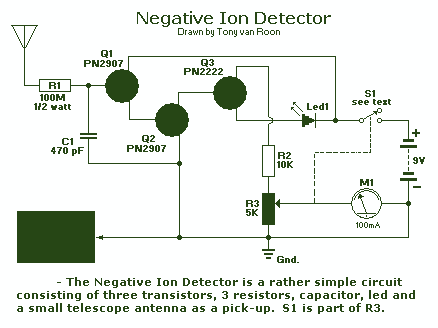
Car Parking Sensor schematic
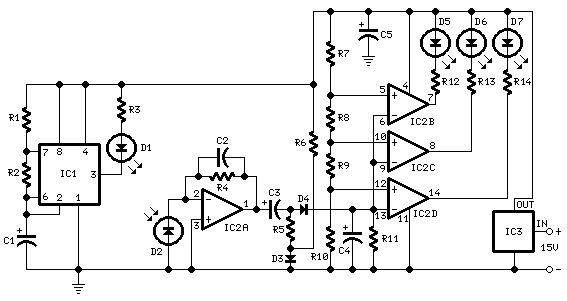
This circuit assists in parking a car near a garage wall by providing distance alerts. LED D7 illuminates when the bumper-wall distance is approximately 20 cm. When the distance decreases to about 10 cm, both D7 and D6 illuminate, and at around 6 cm, D7, D6, and D5 light up. These alerts indicate that the vehicle is approaching too close to the wall. The distances can vary based on the infrared transmitting and receiving LEDs used, with sensitivity being significantly affected by the color of the reflecting surface; for example, black surfaces reduce sensitivity. This circuit can also be utilized in other applications such as liquid level detection and proximity devices. The infrared photo diode D2 should incorporate an optical sunlight filter and typically comes in black plastic cases. Some resemble TO92 transistors, with the sensitive surface being the curved side rather than the flat side. It is advisable to house all circuitry near the infrared LEDs in a compact enclosure. The three signaling LEDs can be positioned away from the main box at a height for better visibility to the driver. The optimal setup involves bringing D2 closer to D1 (without a reflecting object) until D5 illuminates, then adjusting slightly until D5 turns off. The ideal distance between D1 and D2 typically ranges from 1.5 to 3 cm. Component values include: R1: 10K, R2, R5, R6, R9: 1K, R3: 33Ω, R4, R11: 1M, R7: 4.7K, R8: 1.5K, R10, R12-R14: 1K; capacitors C1, C4: 1 µF/63V, C2: 47pF, C3, C5: 100 µF; diodes D1: Infra-red LED, D2: Infra-red Photo Diode, D3, D4: 1N4148, D5-D7: LEDs (of any color and size); integrated circuits IC1: NE555, IC2: LM324, IC3: LM7812.
This parking assistance circuit is designed to enhance safety by providing visual alerts to the driver as they reverse their vehicle towards a garage wall. The primary components include infrared LEDs for transmission and a photo diode for reception, which work together to measure the distance to the wall. The system operates on the principle of reflected infrared light; as the vehicle approaches the wall, the intensity of the reflected light changes, triggering the corresponding LEDs to illuminate based on the preset distance thresholds.
The use of an NE555 timer (IC1) allows for precise timing control and signal processing, while the LM324 operational amplifier (IC2) can be used to amplify the signals received from the photo diode, ensuring that even minor changes in distance are detected. The LM7812 voltage regulator (IC3) ensures that the circuit operates at a stable voltage, which is crucial for maintaining consistent performance.
The choice of component values is critical for the desired sensitivity and response time of the circuit. Resistors R1 through R14 provide the necessary biasing and current limiting for the LEDs and the operational amplifier, while the capacitors help filter noise and stabilize the power supply. The infrared photo diode (D2) must be carefully selected to ensure it has an appropriate optical filter to minimize interference from ambient sunlight, thus enhancing the accuracy of distance measurement.
For practical implementation, it is recommended to assemble the circuit in a compact enclosure to protect the components and allow for easy installation in the vehicle. The signaling LEDs should be mounted in a position that is easily visible to the driver, ensuring that alerts can be quickly recognized during parking maneuvers. Proper calibration of the distance sensors is also essential, with adjustments made to ensure that the LED indicators provide accurate feedback as the vehicle approaches the wall.This circuit can be used for an assist in parking the car near the garage wall backing up Pls. LED D7 illuminates Pls bumper-wall distance is about 20 cm. , D7 + D6 illuminate at about 10 cm. and D7 + D6 + D5 at about 6 cm. In this manner you are alerted Pls approaching too close to the wall. All distances mentioned before can vary, depending on in fra-red transmitting and receiving LEDs used and are mostly affected by the color of the reflecting surface. Black surfaces lower greatly the device sensitivity. Obviously, you can use this circuit in other applications like liquids level detection, proximity devices etc.
The infra-red Photo Diode D2, should be of the type incorporating an optical sunlight filter: these components appear in black plastic cases. Some of them resemble TO92 transistors: in this case, please note that the sensitive surface is the curved, not the flat one.
It is wiser to place all the circuitry near the infra-red LEDs in a small box. The 3 signaling LEDs can be placed far from the main box at an height making them well visible by the car driver. The best setup is obtained bringing D2 nearer to D1 (without a reflecting object) until D5 illuminates; then moving it a bit until D5 is clearly off.
Usually D1-D2 optimum distance lies in the range 1. 5-3 cm. R1 : 10K R2, R5, R6, R9 : 1K R3 : 33R R4, R11 : 1M R7 : 4K7 R8 : 1K5 R10, R12-R14 : 1K C1, C4 : 1 µF/63V C2 : 47pF C3, C5 : 100 µF D1 : Infra-red LED D2 : Infra-red Photo Diode (see Notes) D3, D4 : 1N4148 D5-7 : LEDs (Any color and size) IC1 : NE555 IC2 : LM324 IC3 : LM7812 🔗 External reference
This parking assistance circuit is designed to enhance safety by providing visual alerts to the driver as they reverse their vehicle towards a garage wall. The primary components include infrared LEDs for transmission and a photo diode for reception, which work together to measure the distance to the wall. The system operates on the principle of reflected infrared light; as the vehicle approaches the wall, the intensity of the reflected light changes, triggering the corresponding LEDs to illuminate based on the preset distance thresholds.
The use of an NE555 timer (IC1) allows for precise timing control and signal processing, while the LM324 operational amplifier (IC2) can be used to amplify the signals received from the photo diode, ensuring that even minor changes in distance are detected. The LM7812 voltage regulator (IC3) ensures that the circuit operates at a stable voltage, which is crucial for maintaining consistent performance.
The choice of component values is critical for the desired sensitivity and response time of the circuit. Resistors R1 through R14 provide the necessary biasing and current limiting for the LEDs and the operational amplifier, while the capacitors help filter noise and stabilize the power supply. The infrared photo diode (D2) must be carefully selected to ensure it has an appropriate optical filter to minimize interference from ambient sunlight, thus enhancing the accuracy of distance measurement.
For practical implementation, it is recommended to assemble the circuit in a compact enclosure to protect the components and allow for easy installation in the vehicle. The signaling LEDs should be mounted in a position that is easily visible to the driver, ensuring that alerts can be quickly recognized during parking maneuvers. Proper calibration of the distance sensors is also essential, with adjustments made to ensure that the LED indicators provide accurate feedback as the vehicle approaches the wall.This circuit can be used for an assist in parking the car near the garage wall backing up Pls. LED D7 illuminates Pls bumper-wall distance is about 20 cm. , D7 + D6 illuminate at about 10 cm. and D7 + D6 + D5 at about 6 cm. In this manner you are alerted Pls approaching too close to the wall. All distances mentioned before can vary, depending on in fra-red transmitting and receiving LEDs used and are mostly affected by the color of the reflecting surface. Black surfaces lower greatly the device sensitivity. Obviously, you can use this circuit in other applications like liquids level detection, proximity devices etc.
The infra-red Photo Diode D2, should be of the type incorporating an optical sunlight filter: these components appear in black plastic cases. Some of them resemble TO92 transistors: in this case, please note that the sensitive surface is the curved, not the flat one.
It is wiser to place all the circuitry near the infra-red LEDs in a small box. The 3 signaling LEDs can be placed far from the main box at an height making them well visible by the car driver. The best setup is obtained bringing D2 nearer to D1 (without a reflecting object) until D5 illuminates; then moving it a bit until D5 is clearly off.
Usually D1-D2 optimum distance lies in the range 1. 5-3 cm. R1 : 10K R2, R5, R6, R9 : 1K R3 : 33R R4, R11 : 1M R7 : 4K7 R8 : 1K5 R10, R12-R14 : 1K C1, C4 : 1 µF/63V C2 : 47pF C3, C5 : 100 µF D1 : Infra-red LED D2 : Infra-red Photo Diode (see Notes) D3, D4 : 1N4148 D5-7 : LEDs (Any color and size) IC1 : NE555 IC2 : LM324 IC3 : LM7812 🔗 External reference
